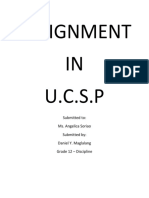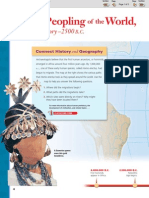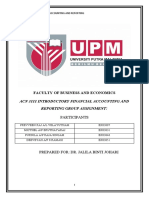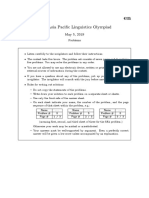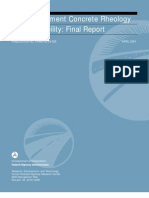Callao Man
Callao Man
Uploaded by
Dave EvangelioCopyright:
Available Formats
Callao Man
Callao Man
Uploaded by
Dave EvangelioOriginal Title
Copyright
Available Formats
Share this document
Did you find this document useful?
Is this content inappropriate?
Copyright:
Available Formats
Callao Man
Callao Man
Uploaded by
Dave EvangelioCopyright:
Available Formats
With Philippines having more than 7,000 islands, it is considered as one in a million
discoveries for archaeologists to find a cache of carved rhino bones and hundreds of
stone tools on the largest island in the Philippines, Luzon. This is the Callao Man also
known as ‘Homo Luzonensis’, known as the second dwarf human. Homo Luzonensis
were the only hominids that inhabited Luzon Island. While exploring the rocky floor and
the cold caves of Callao Cave on Luzon Island, researchers uncovered a number of
fossils from what might be an ancient human species that have never been discovered
before. Archaeologists are curious who exactly these ancient people were and how they
crossed the deep seas that covered the island and others in South East Asia.
Homo luzonensis, this species inhabited Luzon more than 50,000 years ago. They lived
at the same time with the more advanced species the Homo neanderthalensis and the
Homo sapiens, or modern humans. These early humans also lived at the same time as
the “Hobbit” species, Homo floresiensis a species found in Indonesia, but their tooth and
foot shape, along with other traits, mark them as a distinct species all their own. Back in
2007, archaeologists in Luzon discovered a single foot bone (or metatarsal) in Callao
Cave, which they dated to 67,000 years ago. Analysis of that fossil suggested it
belonged to a member of the genus Homo, but they didn’t know which species. The
fossils found in the cave—including several foot and hand bones, a partial femur and
teeth—shared some with more primitive hominin species such as Australopithecus and
Homo erectus, as well as more advanced ones, including Homo sapiens and Homo
floresiensis. The fossils found in the cave included several foot and hand bones, partial
femur and teeth. What really got me interested was the teeth, as there are no other
species that have the same traits as the Homo Luzonensis. The foot bones they dug up
is different from the bones that you’d see today, the bones had features which would’ve
made climbing trees easier and while still walking on two legs upright.
Discovering and finding our pasts feels really satisfying, it is like being able to move one
more step towards completely understanding who we really are. This discovery is a
great stepping stone for us to gain understanding about how the Filipino race developed
and give us a background study of how our ancestors live in the past. We should
investigate and study our pasts and see how different or how similar they lived to us
modern humans. Through learning more about our past we can all develop the same
sense of appreciation towards how our ancestors continued to prolong and develop our
species. Without them we would probably be stuck in a more primitive era of humans.
You might also like
- Candidate'S Guide: Wizz Air Pilot RecruitmentDocument25 pagesCandidate'S Guide: Wizz Air Pilot RecruitmentAlex AlexandruNo ratings yet
- Entrance Examination For STEM MathematicsDocument2 pagesEntrance Examination For STEM MathematicsEmelyn V. Cudapas89% (9)
- Human Evolution ZOOLOGY PROJECTDocument11 pagesHuman Evolution ZOOLOGY PROJECTpravenkumar100% (3)
- Sixth Grade Social Science (For Homeschool or Extra Practice)From EverandSixth Grade Social Science (For Homeschool or Extra Practice)No ratings yet
- LUCY PresentationDocument16 pagesLUCY PresentationAlexanderRoxasNo ratings yet
- Guiness - Good ThingsDocument4 pagesGuiness - Good ThingsLivia PleteaNo ratings yet
- Whole Foods Market Capstone ProjectDocument16 pagesWhole Foods Market Capstone ProjectTasha Mays100% (1)
- Homo LuzonensisDocument3 pagesHomo LuzonensisJepney ArellanoNo ratings yet
- New Species of Ancient Human Discovered in The PhilippinesDocument6 pagesNew Species of Ancient Human Discovered in The PhilippinesJepney ArellanoNo ratings yet
- Homo Floresiensis: Year of Discovery: 2003history of DiscoveryDocument4 pagesHomo Floresiensis: Year of Discovery: 2003history of DiscoveryMargie Ballesteros ManzanoNo ratings yet
- DAY 1 Passage 1Document2 pagesDAY 1 Passage 1wick90715No ratings yet
- EvolutionDocument4 pagesEvolutionDiana Tomas SalvadorNo ratings yet
- Homo HabilisDocument12 pagesHomo HabilisCelia Sayoto HidalgoNo ratings yet
- L - Paper 1Document2 pagesL - Paper 1nilaygoNo ratings yet
- Day 6 Full Test-1-3Document3 pagesDay 6 Full Test-1-3xusniddine273No ratings yet
- About the Little People: Fairies, Elves, Dwarfs, and LeprechaunsFrom EverandAbout the Little People: Fairies, Elves, Dwarfs, and LeprechaunsNo ratings yet
- Evolution Article Reflection PaperDocument2 pagesEvolution Article Reflection PaperGARCIA, Marvin T. STEM1103No ratings yet
- Eed 6 Unit 1 Part 3 StudentsDocument11 pagesEed 6 Unit 1 Part 3 StudentsMhaebilyn DizonNo ratings yet
- Proposing Explanations For Fossil FootprintsDocument2 pagesProposing Explanations For Fossil FootprintsMelphen LagenioNo ratings yet
- Notebook Lesson by SlidesgoDocument6 pagesNotebook Lesson by SlidesgoI am not okNo ratings yet
- Anoba, CD- Philippines as a Spotlight in Human Evolution and Transformation a Book Review on the Pre-16th Century Annotated Compilation of Selected Philippine History Primary Sources and Secondary Works in Electronic FormatDocument11 pagesAnoba, CD- Philippines as a Spotlight in Human Evolution and Transformation a Book Review on the Pre-16th Century Annotated Compilation of Selected Philippine History Primary Sources and Secondary Works in Electronic FormatCristian Del AnobzNo ratings yet
- Curs - I.1103 - World PrehistoryDocument54 pagesCurs - I.1103 - World PrehistoryCristina MariaNo ratings yet
- Cagayan Valley Philippines: Cagayan Man Refers To A Group of Humans That Inhabited TheDocument27 pagesCagayan Valley Philippines: Cagayan Man Refers To A Group of Humans That Inhabited TheCiena Mae100% (1)
- Australopiticus and Homo HabilisDocument17 pagesAustralopiticus and Homo HabilisThea SprouseNo ratings yet
- Lucy's DiscoveryDocument2 pagesLucy's DiscoveryScribdTranslationsNo ratings yet
- Reaction Paper in ArkeoDocument2 pagesReaction Paper in ArkeoFraul Tadle100% (3)
- Homo ErectusDocument8 pagesHomo ErectusKristelNo ratings yet
- Biological and Cultural Evolution From Homo Habilis ToDocument35 pagesBiological and Cultural Evolution From Homo Habilis ToAriesjane OrtegaNo ratings yet
- Primate Evolution: Chapter OutlineDocument22 pagesPrimate Evolution: Chapter OutlineJuan Antonio Valls FerrerNo ratings yet
- Paleoanthropology: What Can Anthropologists Learn From Ancient Bones?Document2 pagesPaleoanthropology: What Can Anthropologists Learn From Ancient Bones?Patrick LawagueNo ratings yet
- Human OriginsDocument6 pagesHuman Origins039QONITA INDAH ARRUSLINo ratings yet
- Hobbit - Homo FloresiensisDocument9 pagesHobbit - Homo FloresiensisKiichi13No ratings yet
- Archaic HomoDocument12 pagesArchaic HomoJussel Catalo IINo ratings yet
- UCSP Biological and Cultural Evolution of Human BeingsDocument2 pagesUCSP Biological and Cultural Evolution of Human BeingsJilli ChilliNo ratings yet
- Evolution of ManDocument2 pagesEvolution of ManVin Myca SagarinoNo ratings yet
- Ucsp 1Document14 pagesUcsp 1whisperdaydream24No ratings yet
- 11th His Chapter 1Document17 pages11th His Chapter 1Nitish DhenwalNo ratings yet
- Lucy PaperDocument7 pagesLucy PaperMichael ChangNo ratings yet
- X2 - Muhammad Zaki Azdzikra - 18 - MuseumSangiranReportDocument6 pagesX2 - Muhammad Zaki Azdzikra - 18 - MuseumSangiranReportMuhammad Zaki AzdzikraNo ratings yet
- The Hominidae, Whose Members Are Known As Great Apes or Hominids, Are A Taxonomic Family of PrimatesDocument1 pageThe Hominidae, Whose Members Are Known As Great Apes or Hominids, Are A Taxonomic Family of PrimatesRockyNo ratings yet
- Fossils: Records of Prehistoric Life in The PhilippinesDocument86 pagesFossils: Records of Prehistoric Life in The Philippinesvinb100% (1)
- Do Roman Catholics KnOw Hobbits Weren't Humans?Document3 pagesDo Roman Catholics KnOw Hobbits Weren't Humans?.No ratings yet
- RPH Part-2Document6 pagesRPH Part-2Andrei GattoNo ratings yet
- Human Biocultural and Social Evolution: (From Homo Habilis To Homo Sapiens)Document10 pagesHuman Biocultural and Social Evolution: (From Homo Habilis To Homo Sapiens)Philipjommel MilanoNo ratings yet
- ASSIGNMENTDocument5 pagesASSIGNMENTDaniel MaglalangNo ratings yet
- Biological and Cultural EvolutionDocument55 pagesBiological and Cultural EvolutionKarl Rigo Andrino100% (3)
- To Trace Back The Evolutionary History of Homo Sapiens SapiensDocument15 pagesTo Trace Back The Evolutionary History of Homo Sapiens SapiensgrafixitisNo ratings yet
- Human EvolutionDocument10 pagesHuman EvolutionVenn Bacus Rabadon0% (1)
- Chapter 1 From History BookDocument20 pagesChapter 1 From History Bookjoenacchus brashNo ratings yet
- Origins of The Human RaceDocument2 pagesOrigins of The Human RaceAin SoberanoNo ratings yet
- PENEMUAN MAN-WPS OfficeDocument10 pagesPENEMUAN MAN-WPS Officedaffanafiish4No ratings yet
- Fossils Records of Prehistoric Life 07292022Document84 pagesFossils Records of Prehistoric Life 07292022Jelou Dianne DemafelizNo ratings yet
- Philippines Prehistoric PeopleDocument6 pagesPhilippines Prehistoric PeopleEllen Grace PlacidoNo ratings yet
- Biological Ang CulturalDocument12 pagesBiological Ang CulturalClariz Ann MirandaNo ratings yet
- The Fallacies of The DeepDocument4 pagesThe Fallacies of The DeepDexter CaroNo ratings yet
- FDF '''''''' (J Hgyghuman Evolution: Homo HabilisDocument19 pagesFDF '''''''' (J Hgyghuman Evolution: Homo HabilisRalph MaglasangNo ratings yet
- Homo RudolfensisDocument3 pagesHomo RudolfensisBEAN tvNo ratings yet
- Callao ManDocument2 pagesCallao ManLenie AlonzoNo ratings yet
- Block-1 HISTORYDocument72 pagesBlock-1 HISTORYdanish mohammadNo ratings yet
- Origin of Huan RaceDocument6 pagesOrigin of Huan RaceJenell F. LumaluNo ratings yet
- Overview of ProjectDocument14 pagesOverview of Projectofmephotos4No ratings yet
- Origins of Modern HumansDocument8 pagesOrigins of Modern HumansMalaya GenotivaNo ratings yet
- Biological Evolution of Early Humans and Modern Humans: Understanding Culture, Society and PoliticsDocument24 pagesBiological Evolution of Early Humans and Modern Humans: Understanding Culture, Society and PoliticsJansenn PastorNo ratings yet
- Between Ape and Human: An Anthropologist on the Trail of a Hidden HominoidFrom EverandBetween Ape and Human: An Anthropologist on the Trail of a Hidden HominoidNo ratings yet
- Gmail - Your Test ResultsDocument2 pagesGmail - Your Test ResultsRonal'd GonzÁlezNo ratings yet
- Paritala Ravi StoryDocument11 pagesParitala Ravi Storykonangi_vinodNo ratings yet
- Acc Assignment Merge UpdatedDocument9 pagesAcc Assignment Merge UpdatedDEEVEYAH A/P S.RAMASI / UPM0% (1)
- Phylum ChordataDocument2 pagesPhylum Chordatarishabh kumar ShuklaNo ratings yet
- Math 11 PreCal STEM Q2-Week 8Document10 pagesMath 11 PreCal STEM Q2-Week 8Jessa Cuanan CaloNo ratings yet
- First Asia Pacific Linguistics Olympiad: ProblemsDocument8 pagesFirst Asia Pacific Linguistics Olympiad: ProblemsLolTheBob100% (1)
- ECO401 Latest Solved Mcqs With Reference Mega FileDocument78 pagesECO401 Latest Solved Mcqs With Reference Mega FilekiranNo ratings yet
- NSTC 9 Sample Paper 2011 13 V1Document24 pagesNSTC 9 Sample Paper 2011 13 V1M Nisar Chishti Hassan100% (1)
- Technicalanalysis Astudyonselectedstocks 120105030453 Phpapp02Document76 pagesTechnicalanalysis Astudyonselectedstocks 120105030453 Phpapp02Ankita DoddamaniNo ratings yet
- Guarded Girls Sample 2Document2 pagesGuarded Girls Sample 2Aindrila KaziNo ratings yet
- MiniMax AlgorithmDocument1 pageMiniMax AlgorithmRashi BaranwalNo ratings yet
- Are Video Games Educational?: Retrieved From: Visited1/7/14Document1 pageAre Video Games Educational?: Retrieved From: Visited1/7/14juanelgaNo ratings yet
- Banks Are Building The Next Wave of Embedded Finance 1698157006Document40 pagesBanks Are Building The Next Wave of Embedded Finance 1698157006Abde IssamNo ratings yet
- Methanol Poisoning: Management With EthanolDocument20 pagesMethanol Poisoning: Management With EthanolSALIM AL MAQBALINo ratings yet
- DNA Structure & ReplicationDocument25 pagesDNA Structure & Replicationivanam0202No ratings yet
- Cerebro Perdedor de SalDocument14 pagesCerebro Perdedor de SalGabyRamónNo ratings yet
- 902917-CCC-GSP04-01 Devil King Highschool Year One - Printer FriendlyDocument30 pages902917-CCC-GSP04-01 Devil King Highschool Year One - Printer FriendlyCallum OakesNo ratings yet
- Sakalakala Valli MalaiDocument6 pagesSakalakala Valli MalaiDurga Devi Muthusubramanian0% (1)
- Medical and Musical Byways of Mozartiana (Review by Henry Caleb Powell)Document4 pagesMedical and Musical Byways of Mozartiana (Review by Henry Caleb Powell)dominicIVNo ratings yet
- Benefits: Employees TPI-theoryDocument2 pagesBenefits: Employees TPI-theorylollaNo ratings yet
- The Kashmirian AtharvavedaDocument49 pagesThe Kashmirian Atharvavedaའཇིགས་བྲལ་ བསམ་གཏན་No ratings yet
- Portland-Cement Concrete Rheology and Work AbilityDocument111 pagesPortland-Cement Concrete Rheology and Work AbilityRudiele SchankoskiNo ratings yet
- Brahmacharya by Swami VivekanandaDocument5 pagesBrahmacharya by Swami VivekanandabaizubirajiNo ratings yet
- Apricot Jelly Turkish Sheet - Google SearchDocument1 pageApricot Jelly Turkish Sheet - Google SearchKashaf ShahraazNo ratings yet
- Product CatalogueDocument13 pagesProduct CatalogueAli Hassan TariqNo ratings yet
- Academic Paper Articles of Faith Theology 1Document10 pagesAcademic Paper Articles of Faith Theology 1LYNUS OLIVER DEL MARNo ratings yet












































